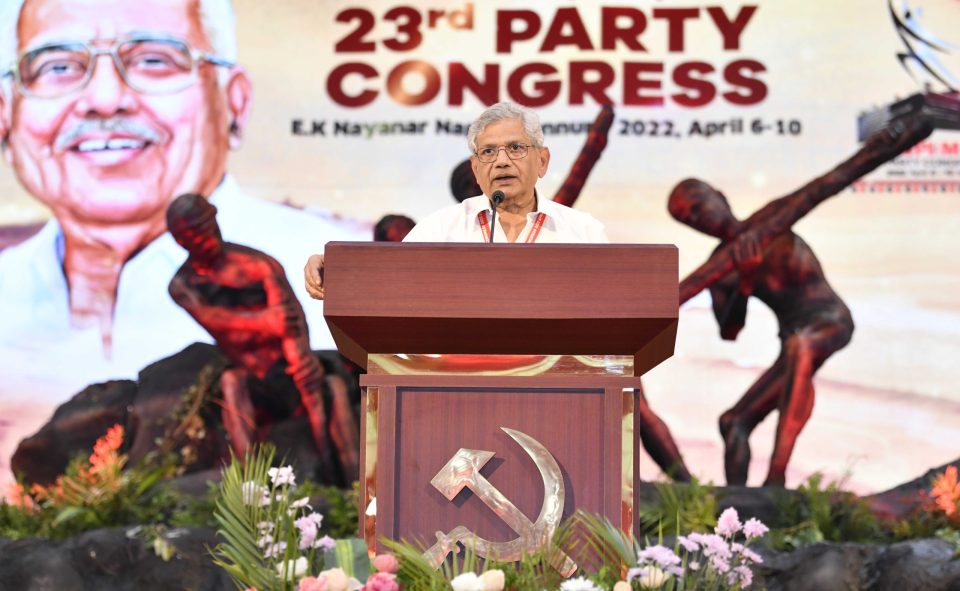
CPI(M) membership has slumped, party failed to recognise BJP strength: Report
Even after eight years of BJP, many of the cadres fail to grasp the danger posed by the RSS ideology and its growing influence among the people, said the internal report

The interventional capacities of the Communist Party of India (Marxist – CPI-M) have declined in a big way, observed the organisational report presented at the 23rd party congress.
A decline in membership and independent strength and the failure to foresee the growth of the BJP are the most challenging situations the party is facing since its formation in 1964, said the report, a copy of which The Federal has access. Many state units have become mundane in organising struggles and raising local issues, it added.
There is a decline of 3.86% in membership from the time of the 22nd Party Congress (2017) to the present. The party membership strenght in 2017 was 10,25,352, which has since fallen to 9,99,121.
“The bulk of this reduction was due to the fall in membership in West Bengal and Tripura due to the continuous attacks and repression the party had been facing,” the report said.
Membership quality erosion
The organisational report has analysed that there is erosion in the quality of membership as well. As far as the CPI(M )is concerned, the membership is based on five-point criteria — payment of levy, regular attendance in branch meetings, active participation in party classes and political campaigns, being an active participant in mass movements, and regular reading and subscription of the party organs.
It was found that except Kerala, West Bengal, Tripura and Andhra Pradesh, no state unit follows the membership criteria.
As per district reports from West Bengal, 30–35% of the members are inactive. In Tripura, only 42 per cent of the members participate in political campaigns and mass movements.
On the other hand, there is a tangible increase in the participation of women, said the report. In Kerala, the membership of women increased from 17.21% in 2017 to 19.75 % in 2021. In Tamil Nadu, the number of women increased from 15% to 21.6%. In Andhra Pradesh, the women membership has increased from 18% to 21% and in Delhi, from 31% to 32.5%. The number of women members grew from 9% to 12% in Jharkhand and 26% to 32% in Karnataka.
On the contrary, the participation of women has drastically fallen in Tripura and UP, where it came down from 28% to 20% and from 10% to 8.7% respectively.
However, the data show that the increase in the membership does not have a corresponding reflection in the participation of women in higher level committees. The increase in the number of women in state committees is very nominal in all states, including Kerala. The previous state committee had 11 women and the present one has 13 in Kerala.
Strategic fallouts
The report observed that the party has lost its edge in focusing on defeating BJP. The West Bengal state committee failed to rightly assess the escalating tension between the Trinamool Congress and BJP, it said.
“The state committee has assessed the relation between BJP and TMC as a collusion between the two to create bipolarity in the state. The consequent growing confrontation between the BJP and the ruling party was underestimated. This resulted in diluting the sharpness of the anti-BJP campaign and often equating BJP and Trinamool Congress in practice,” stated the report.
There is erosion in mass bases in all states except Kerala, the report said. In the Tamil Nadu Assembly, the party managed to win two out of six seats contested, but the independent strength of the party is weakening. The vote share is not increasing even in constituencies where the party contested many times. The Tamil Nadu state committee said in its review that “unless the independent strength is increased, the party cannot ensure victory in the future”.
Reckoning with the Sangh
“There is a continuous weakness in raising the ideological level of the party cadres and members,” said the report, referring to the deepening influence of Hindutva ideology. “Even after eight years of BJP rule at the Centre, many of the cadres fail to grasp the danger posed by the RSS ideology and their growing influence among the people,” said the organisational report.
In states where the BJP is not strong, party cadres tend to see the respective ruling parties as the main opponents and underestimate the threat posed by the BJP.
For example, in Andhra Pradesh, the party cadres are more against the ruling YSRCP than the BJP. Earlier in West Bengal, the threat posed by the BJP was not understood by a large section of the party and the main focus was on fighting against the TMC. In Tripura too, the party could not comprehend the growth of BJP.
The report further said the form of protests and struggles have been routinised and have become merely token expressions. “It has become a routine to take up any state or local issue by holding up a routine by just holding some dharna or protest demonstration by the party cadres or activists,” it stated.


